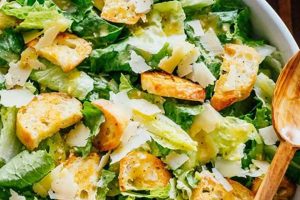Fresh, vibrant salads featuring leafy greens, often romaine or butter lettuce, combined with characteristically Mexican ingredients like cilantro, avocado, jicama, corn, tomatoes, onions, and peppers, dressed in citrus-based vinaigrettes or creamy dressings incorporating ingredients such as chili powder or cumin, exemplify this culinary category. A simple example includes chopped romaine, diced tomatoes, avocado, red onion, cilantro, and a lime vinaigrette.
These salads offer a refreshing counterpoint to richer Mexican fare, providing essential vitamins, minerals, and fiber. They represent a lighter, healthier approach to enjoying the vibrant flavors of Mexican cuisine, adapting readily to seasonal produce and individual preferences. Historically, salads in Mexican cuisine were simpler, often utilizing readily available ingredients. The evolution to more complex combinations reflects both culinary innovation and the increasing availability of diverse ingredients.
The following sections will explore variations within this category, including specific recipes, dressing options, and suggestions for ingredient substitutions and additions to cater to diverse dietary needs and preferences.
Tips for Crafting Exceptional Green Salads with Mexican Flavors
Elevating a simple green salad to showcase the vibrancy of Mexican cuisine involves careful consideration of ingredients, textures, and flavors. These tips offer guidance for creating exceptional salads.
Tip 1: Embrace Fresh Herbs: Generous use of cilantro, oregano, and mint elevates the flavor profile, creating an authentically Mexican taste.
Tip 2: Explore Citrus Varieties: Lime juice is traditional, but other citrus fruits like orange or grapefruit offer unique flavor dimensions. Experiment to find preferred combinations.
Tip 3: Consider Textural Contrast: Combine crisp lettuce with creamy avocado, crunchy jicama, or toasted pepitas for an engaging textural experience.
Tip 4: Balance Flavors: The bright acidity of citrus should balance the richness of avocado and the heat of chiles. Careful balancing ensures a harmonious final product.
Tip 5: Utilize Authentic Chiles: Fresh or dried chiles, like jalapeos, serranos, or poblanos, add depth and complexity beyond basic spice.
Tip 6: Select Quality Ingredients: The freshest produce, ripe avocados, and flavorful herbs are crucial for optimal results.
Tip 7: Dress Strategically: Dress the salad just before serving to prevent the greens from becoming soggy. Lightly coating each leaf ensures even flavor distribution.
By implementing these tips, one can consistently achieve flavorful and visually appealing salads that capture the essence of Mexican cuisine. These foundational principles provide a springboard for culinary creativity.
The following section will present specific recipe examples, illustrating the practical application of these techniques.
1. Fresh Ingredients
The foundation of any exceptional Mexican green salad lies in the quality and freshness of its components. Utilizing peak-season produce elevates the flavor profile and contributes to a more vibrant and satisfying culinary experience. Ingredient selection directly impacts the overall taste, texture, and nutritional value of the final dish.
- Leafy Greens:
Crisp, fresh lettuces like romaine, butter lettuce, or even baby spinach provide the base for these salads. The choice of greens influences the texture and flavor profile. Romaine offers a robust crunch, while butter lettuce contributes a delicate sweetness. Washed and thoroughly dried greens are essential for preventing a soggy salad.
- Herbs and Aromatics:
Fresh cilantro, a staple in Mexican cuisine, provides a bright, citrusy note. Other herbs like oregano and mint can also be incorporated to add complexity and depth. Finely chopped white or red onion adds a pungent bite, while garlic can be used sparingly for a subtle savory undertone. These aromatic elements contribute significantly to the overall flavor profile.
- Vegetables:
Incorporating fresh vegetables like tomatoes, cucumbers, radishes, bell peppers, corn, or jicama adds nutritional value, textural contrast, and visual appeal. Ripe, in-season tomatoes offer sweetness and juiciness, while jicama provides a refreshing crunch. The selection of vegetables can be adapted based on seasonal availability and personal preferences.
- Avocados:
Ripe avocados contribute a creamy richness and healthy fats. Their smooth texture complements the crispness of the greens and other vegetables. Properly ripened avocados should yield slightly to gentle pressure but not feel mushy. They are a key component in many Mexican green salads, adding both flavor and nutritional value.
The emphasis on fresh, high-quality ingredients distinguishes authentic Mexican green salads. The interplay of flavors and textures resulting from this careful selection creates a vibrant and satisfying dish. The freshness of the ingredients not only enhances the taste but also contributes to the overall nutritional value of the salad, making it a healthy and flavorful culinary choice.
2. Vibrant Flavors
Vibrant flavors are a defining characteristic of Mexican cuisine, and these salads are no exception. This vibrancy arises from a complex interplay of contrasting yet complementary tastes: the bright acidity of citrus juices, the subtle heat of chiles, the earthy depth of spices, and the fresh notes of herbs. The careful balance of these elements creates a dynamic flavor profile that engages the palate. For instance, a lime vinaigrette provides a refreshing tang that cuts through the richness of avocado, while a touch of chili powder adds a warm, savory depth. This interplay prevents any single flavor from dominating, resulting in a harmonious and multi-dimensional taste experience.
Achieving this balance requires an understanding of the individual ingredients and their contributions to the overall flavor profile. Lime juice, a staple in Mexican cooking, provides brightness and acidity. Chiles, ranging from mild jalapeos to fiery habaneros, introduce varying levels of heat. Spices like cumin, coriander, and oregano add earthy, warm notes. Fresh herbs, particularly cilantro, contribute a bright, citrusy element. The specific combination and proportions of these ingredients determine the final flavor profile, allowing for a wide range of variations within the category. A salad featuring grilled corn, black beans, cotija cheese, and a chipotle-lime dressing exemplifies the interplay of smoky, spicy, tangy, and savory flavors.
Understanding the role of each flavor component enables informed decisions regarding ingredient selection and proportion, leading to more complex and satisfying salads. The careful calibration of these flavors ensures that the final dish is not just a collection of ingredients but a cohesive culinary creation. While variations exist, the core principle remains consistent: the vibrant flavors, achieved through a balanced combination of contrasting tastes, define the essence of a true Mexican green salad. This understanding empowers culinary exploration and adaptation while respecting the fundamental principles of this culinary tradition.
3. Textural Variety
Textural variety is a crucial element in crafting compelling Mexican green salads. A successful salad engages not only the palate through flavor but also the sense of touch through a diverse range of textures. This interplay of textures elevates the eating experience beyond mere sustenance, adding a layer of complexity and enjoyment. The strategic incorporation of contrasting textures transforms a simple salad into a dynamic culinary creation.
- Crunchy Elements:
Crunchy components provide a satisfying contrast to softer ingredients. Examples include crisp lettuce like romaine or iceberg, toasted pepitas (pumpkin seeds), tortilla strips, or jicama. These elements provide textural counterpoints to creamy and smooth components, enhancing the overall sensory experience. The crispness of these additions keeps the salad interesting and prevents it from feeling monotonous.
- Creamy Textures:
Creamy elements contribute richness and a smooth mouthfeel. Avocado is a prime example, offering a buttery texture that complements the crispness of the greens and other vegetables. Other creamy additions might include a dollop of crema fresca or crumbled queso fresco. These elements provide a textural contrast and contribute to the overall balance of the salad.
- Chewy Components:
Chewy textures add another dimension to the salad. Grilled corn kernels offer a pleasant chewiness, as do cooked beans like black beans or pinto beans. These ingredients provide a textural contrast to the crisp and creamy elements, creating a more dynamic and engaging culinary experience.
- Soft Elements:
Softer ingredients like tomatoes, cucumbers, or bell peppers offer a juicy contrast to crunchy elements. These ingredients contribute to the overall balance of textures, preventing the salad from becoming overly crisp or dry. Their inclusion ensures a more harmonious and enjoyable eating experience.
The interplay of these various textures crunchy, creamy, chewy, and soft creates a multi-dimensional sensory experience that distinguishes a well-composed Mexican green salad. The thoughtful incorporation of contrasting textures elevates the dish beyond a simple combination of ingredients into a complex and satisfying culinary creation. This attention to textural detail showcases the depth and sophistication of Mexican cuisine, even in a seemingly simple salad. The combination of textures enhances the overall enjoyment and contributes to a more memorable and satisfying meal.
4. Citrus-Based Dressings
Citrus-based dressings are fundamental to Mexican green salads, providing a bright, acidic counterpoint to the other ingredients. These dressings not only enhance the flavors of the vegetables and herbs but also contribute to the overall balance and freshness of the salad. The citrus component provides a crucial acidic element that cuts through richness and unifies the diverse flavors. Their versatility allows for a wide range of variations, accommodating different flavor profiles and dietary preferences.
- Lime Vinaigrette:
The most common choice, lime vinaigrette offers a simple yet effective way to brighten a Mexican green salad. A basic vinaigrette consists of lime juice, oil (often olive oil or avocado oil), and seasonings such as salt, pepper, and perhaps a touch of cumin or oregano. The tartness of the lime juice complements the richness of avocado and the earthiness of beans or corn, creating a harmonious flavor profile.
- Orange-Lime Dressing:
Combining orange and lime juices creates a more complex citrus profile, offering a balance of sweetness and tartness. This combination works well with salads containing ingredients like jicama, oranges, and red onion, where the sweetness of the orange complements the other flavors without overpowering them. The addition of a touch of honey or agave nectar can further enhance the sweetness and balance the acidity.
- Grapefruit Vinaigrette:
Grapefruit juice provides a slightly more assertive citrus flavor, with a pleasant bitterness that complements bolder ingredients. This type of vinaigrette works well in salads with ingredients like grilled chicken or fish, where the bitterness of the grapefruit cuts through the richness of the protein. The addition of a touch of chili flakes can add a spicy kick to balance the bitterness.
- Citrus-Herb Dressings:
Incorporating fresh herbs like cilantro, oregano, or mint into citrus-based dressings adds another layer of complexity and flavor. Cilantro-lime is a classic combination, while oregano adds an earthy note that complements roasted vegetables. Mint provides a refreshing twist, particularly in salads with fruit or grilled shrimp. These herb additions enhance the overall aroma and taste of the dressing, creating a more vibrant and nuanced flavor profile.
The versatility of citrus-based dressings allows for endless variations, adapting to a variety of ingredients and preferences. From the simple elegance of a lime vinaigrette to the complex interplay of flavors in a citrus-herb dressing, these dressings are an integral component of Mexican green salads. They not only provide essential acidity but also contribute significantly to the overall flavor profile, making them an indispensable element in achieving a truly authentic and satisfying culinary experience.
5. Authentic Herbs & Spices
Authentic herbs and spices are essential for capturing the true essence of Mexican green salads. These aromatic components contribute significantly to the distinctive flavor profiles that differentiate these salads from other culinary traditions. The careful selection and application of specific herbs and spices elevate the salad beyond a simple combination of ingredients, transforming it into a vibrant and complex culinary experience. For example, cilantro, a staple in Mexican cuisine, provides a bright, citrusy note that complements the other flavors, while oregano adds an earthy depth that balances the acidity of lime juice. The interplay of these herbs and spices creates a nuanced flavor profile that is both refreshing and satisfying.
The use of specific spices, such as cumin, chili powder, and smoked paprika, further enhances the complexity of Mexican green salads. Cumin offers a warm, earthy flavor that pairs well with beans, corn, and avocado. Chili powder introduces a subtle heat and depth, while smoked paprika adds a smoky dimension that complements grilled vegetables or proteins. The judicious use of these spices enhances the overall flavor profile without overpowering the freshness of the other ingredients. A salad featuring grilled chicken, corn, black beans, and a chipotle-lime dressing exemplifies the skillful use of spices to create a balanced and flavorful dish.
Understanding the role and interplay of authentic herbs and spices is crucial for crafting truly representative Mexican green salads. These aromatic elements are not mere additions but integral components that contribute significantly to the overall flavor profile and cultural authenticity of the dish. The careful selection and balance of these components distinguish a truly authentic Mexican green salad from a generic salad with Mexican-inspired ingredients. This knowledge allows for informed culinary exploration, enabling the creation of salads that are both flavorful and culturally resonant.
Frequently Asked Questions
This section addresses common inquiries regarding the preparation and enjoyment of Mexican green salads, offering practical guidance and clarifying potential misconceptions.
Question 1: Can iceberg lettuce be used in Mexican green salads?
While romaine or butter lettuce are traditional choices, iceberg lettuce can be substituted for a crisper texture. However, its flavor is milder. Consider adding more flavorful ingredients to compensate.
Question 2: What can be used as a substitute for cilantro if one dislikes its taste?
Flat-leaf parsley can be used as a substitute, though it offers a distinctly different flavor profile. Alternatively, increasing the amount of other herbs like oregano or mint can help compensate for the absence of cilantro.
Question 3: How can spiciness levels be adjusted in these salads?
Spiciness is easily adjusted. Omit chiles entirely for a mild salad. For those who prefer heat, incorporate fresh or dried chiles, adjusting the amount according to preferred spice levels. Begin with a small amount and gradually increase to taste.
Question 4: What are suitable protein additions for a more substantial meal?
Grilled chicken, steak, shrimp, or fish are excellent protein additions. Vegetarian options include beans, lentils, or tofu. Consider the flavor profile of the protein and how it complements the other ingredients.
Question 5: How long can a dressed Mexican green salad be stored?
Dressed salads are best consumed immediately to prevent the greens from becoming soggy. If storage is necessary, store the dressing separately and toss with the salad just before serving.
Question 6: Are there vegan variations for traditional dressings?
Vegan variations are readily achievable. Replace crema fresca with cashew cream or a plant-based yogurt alternative. Ensure any other added ingredients, such as cheeses, are also vegan-friendly.
Understanding these key considerations ensures a successful and enjoyable experience preparing and consuming Mexican green salads. Adaptability and creativity within the fundamental principles allow for a wide range of variations to suit individual preferences.
Exploring specific recipe examples provides further practical guidance and inspiration for incorporating these salads into one’s culinary repertoire.
Mexican Green Salad Recipes
This exploration of Mexican green salad recipes has highlighted the key elements that contribute to their vibrancy and flavor. From the foundational importance of fresh, high-quality ingredients to the nuanced interplay of textures and the balanced use of authentic herbs, spices, and citrus-based dressings, these salads represent a dynamic and refreshing expression of Mexican culinary traditions. The adaptability of these recipes allows for a wide range of variations, accommodating diverse dietary preferences and ingredient availability while remaining true to the core principles of freshness, flavor, and textural complexity.
The continued evolution of Mexican green salad recipes promises further culinary innovation, offering exciting possibilities for both home cooks and professional chefs. By embracing the foundational principles outlined herein, culinary enthusiasts can confidently explore and create their own interpretations, contributing to the ongoing legacy of this vibrant and flavorful culinary tradition.






